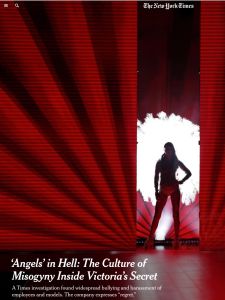Join getAbstract to access the summary!

Join getAbstract to access the summary!
Jessica Silver-Greenberg, Katherine Rosman, Sapna Maheshwari and James B. Stewart
‘Angels’ in Hell
The Culture of Misogyny Inside Victoria’s Secret
The New York Times, 2020
What's inside?
Stories of sexual harassment from models at Victoria’s Secret reveal the misogyny behind its facade of glamour.
Recommendation
The New York Times Magazine reveals the harassment Victoria’s Secret models and other female employees regularly experienced from executive Ed Razek, investor Jeffrey Epstein and photographer Russell James. Women faced name-calling and propositions, and despite reports to HR, these behaviors continued for decades. This exposé by Jessica Silver-Greenberg, Katherine Rosman, Sapna Maheshwari and James B. Stewart reveals a corporate culture fully vested in exploitation and harassment, with few avenues for models and other women to protect themselves.
Summary
About the Authors
New York Times Magazine reporters Jessica Silver-Greenberg, Katherine Rosman, Sapna Maheshwari and James B. Stewart contributed to this article.




















Comment on this summary